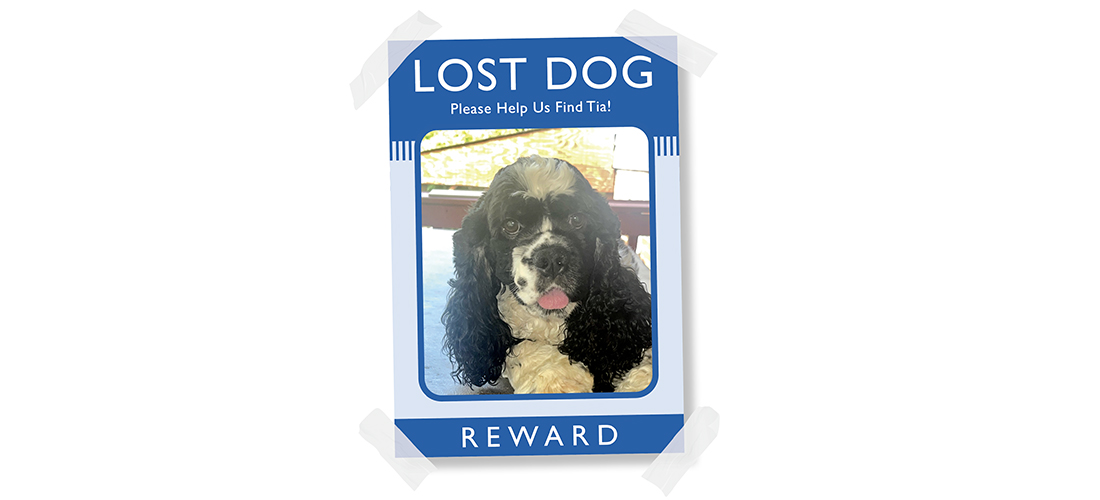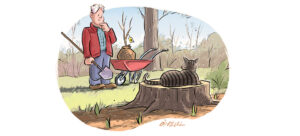
Finding Tia
How a lost dog helped humans locate their kindness
By Maria Johnson
It had just stopped raining, but the sky was still rumbling when I saw her that Sunday afternoon.
She was a little bigger than a bread box. Her black-and-white fur was soaked, and her tail was tucked between her legs as she crept out from between some townhouses about 40 yards away.
She looked like a purebred spaniel, a dog someone would be missing. She also looked scared, just like my foxhound must’ve looked when he slipped out of the yard during a thunderstorm last summer. I remembered how my heart sank when I realized he was gone.
I called to the little spaniel.
She turned and ran the other way. I jumped in the car and drove around the neighborhood hoping to catch a glimpse of her, but she’d seemingly vanished.
So I did what I had done last summer. I sent up a flare on NextDoor, a social media app that connects people in neighborhoods.
“Black and white spaniel pup on the loose … Whitehall neighborhood off Lake Jeanette Road just now . . . ”
Within seconds, people responded with sympathetic emojis. One woman connected the dots, linking my post to a fresh “lost dog” notice from another neighborhood that she also followed.
Soon, I heard from one of the dog’s owners, Virginia Masius.
“I think that’s my dog, Tia,” she wrote.
A little more than an hour earlier, Virginia had let Tia out to relieve herself just before the storm hit. In the time it took Virginia, a professional musician, to fetch her coffee cup from upstairs, the sky opened and thunder shook the house. When she stuck her head outside and called Tia, there was no response.
Virginia looked under the deck. No Tia.
Then she saw a gap under the chain-link fence.
Fear grabbed her.
She tried to calm herself. Four-year-old Tia had wandered off before, but she’d always come back shortly, usually muddy and happy, wagging her thumb-like tail.
Virginia walked her neighborhood of Bellwood Village calling Tia’s name as she went. Nothing.
She texted the news to her partner, Margo Freibott, a professional dog groomer who was driving back from a grooming competition in West Virginia.
In her car, Margo listened to Virginia’s text and dictated a reply: “She’ll come back. Leave the basement door open.”
She suggested that Virginia check the neighborhood retention pond, where wildlife often gathered. Tia, nicknamed Bird Dog, often followed her nose down to the pond.
Then Margo roused the employees at her business, A Becoming Pet in Greensboro. One of them, Brianna Davis, blasted out more social media alerts and left the dinner table to join the hunt as bulletins flashed across NextDoor and the Facebook pages of individuals and animal-related groups.
Text chains lit up among friends: Be on the lookout for a black-and-white cocker spaniel.
Into the evening, people in the Lake Jeanette area scanned their surroundings as they walked, jogged, and exercised their own dogs.
Others searched as they drove, tacking extra miles onto their normal routes in hopes of spotting Tia.
It was getting dark when a woman called Margo.
She’d seen a black-and-white cocker spaniel running up an exit ramp for I-840.
Oh, no, Margo thought. More than anything, she feared Tia trying to cross the partially finished interstate loop.
She and Virginia drove up and down the highway until 9:30 p.m.
They went home dejected.
Margo left voice messages at veterinarian offices. She posted Tia’s information on PawBoost, a site devoted to lost-and-found pets.
Virginia put a venison roast on the gas grill outside, hoping that Tia’s nose, sharpened by hunger, would pick up the molecules of sizzling fat.
They left the gate and the back door standing open, just in case.
They couldn’t sleep.
Where was Tia right now? Was she safe? Was she scared?
The next morning brought a glimmer of hope.
A woman who lived on Cottage Place, about a mile away as the crow flies, posted that her doorbell camera had captured an image of Tia at about 11:30 the night before.
Margo and Virginia chucked their Monday routines and combed the area. Nothing.
They studied Google Earth to guess Tia’s most likely path, figuring the shy dog would stick to easements and creeks.
Margo focused on the neighborhoods that hugged those spaces, retracing streets and parking her car to walk behind developments and call Tia’s name.
Virginia concentrated on distributing “REWARD” flyers bearing Tia’s picture. She stuck the pages to utility poles and stop signs. She dropped off copies at a branch library, a fire station and nearby pet stores.
Everyone she talked to promised to help.
On Monday night, someone on NextDoor posted a picture of Tia taken on Bluff Run Drive.
Indeed, Tia had crossed the interstate, perhaps by going through a culvert that channeled a creek under the road.
A handful of searchers descended on the area, hollering Tia’s name until 10 p.m.
That night, Virginia and Margo felt hope slipping.
Would they see Tia again?
They clung to a lifesaver they’d never expected: The knowledge that dozens — if not hundreds of people — had Tia on their minds, too.
That day, they had run across people walking with treats and leashes in hand.
“Are you looking for the cocker spaniel?” people had asked them, not realizing who Margo and Virginia were.
“Yeah,” they answered.
“We are, too,” the strangers said.
Tuesday morning, when Margo made a brief appearance at work across town, a client commented that she didn’t look well. Margo explained that her dog was missing.
“The cocker spaniel?” the woman replied.
Tuesday afternoon pinged with more sightings in the Bluff Run Drive area.
A house painter had seen her. A dentist had seen her. A couple of women who were walking had seen her.
The tips were promising — and maddening. Margo, Virginia and friends drove from sighting to sighting, literally moving in circles.
Finally, they zeroed in on a swath of woods where they believed Tia was hunkered down. No one had seen her for a couple of hours.
Margo decided to use a live trap loaned to her by retired local wildlife trapper Bobby Farrington. He’d advised her to bait the cage with fried chicken.
Virginia ran to Bojangles.
Margo set the pressure-sensitive trap just inside the woods and sent everyone home. She sat in her car and watched for three hours. At dusk, she saw a family of deer enter the woods. They looked like the herd that had frequented her neighborhood retention pond before construction had driven them away.
Had Tia followed her nose to familiar animals and bedded down near them at night?
Was she overnighting with friends?
That night, Margo left for the Raleigh-Durham International Airport to pick up her 25-year-old son Cody, who was flying home from Oregon to get his car. On the way home, they stopped to check the trap. It was 1 a.m.
They shined a flashlight into the woods.
Two yellow eyes reflected back at them.
“I’m going down there,” said Cody.
A few seconds later, he spoke again.
“Mom, it’s Tia.”
Sitting on a sofa in the family’s living room, Margo continuously runs her fingers through Tia’s wavy fur.
Every few minutes, her fingers feel a bump, and Margo checks to see if it’s a scab where a tick was removed. They found 26 ticks on Tia when they got her home.
Tia stank, too. Margo figured that she had been eating the remains of dead animals in the woods. Margo’s employees bathed Tia repeatedly to get the smell out.
The fence where Tia slipped out? It’s more secure than Fort Knox now.
And Tia? She crawls all over a visitor on the other end of the sofa.
“Oh, now you come to me, huh?” I tease.
It’s mid-May, a couple of weeks since Tia returned from her two-and-a-half-day holiday, and she seems as happy-go-lucky as ever.
Her humans, though, are forever stamped by the experience, especially the feeling of community that Tia’s disappearance prompted.
“It makes me get goosebumps,” Margo says.
“We were amazed at the outpouring of support,” adds Virginia, who had recently considered quitting Facebook because of the divisive tone that has run rampant in the last several years.
This time, though, social media — and the feelings awakened by an 18-pound pup — led people to reveal their better sides.
“Just when you think you’re losing faith in humanity, your little dog goes out and shows you otherwise,” says Margo. OH
Maria Johnson is a contributing editor of O.Henry magazine. You can reach her at ohenrymaria@gmail.com.





